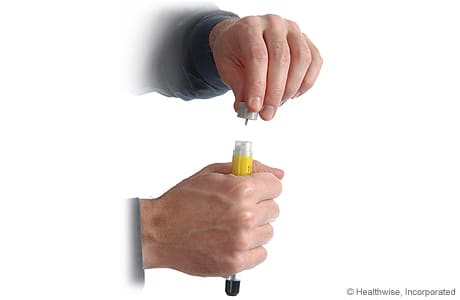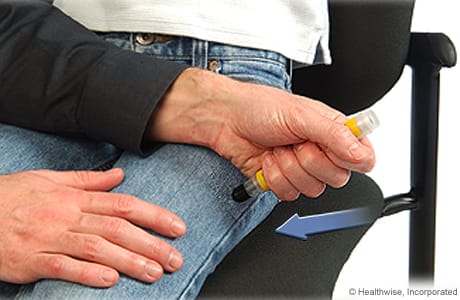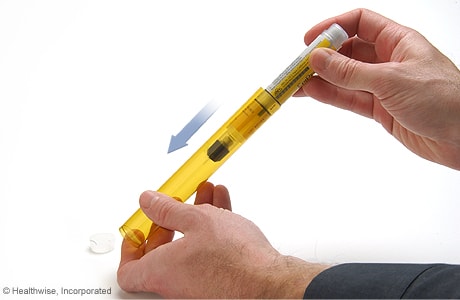Top of the pageActionset
Allergies in Children: Giving an Epinephrine Shot to a Child
If your child has had a severe allergic reaction (anaphylaxis) in the past, you know how frightening it can be. Symptoms of breathing problems, itching, belly pain, nausea or vomiting, diarrhea, and swelling can come on quickly and become life-threatening. Giving your child an epinephrine medicine can slow down or stop an allergic reaction. That's why it is important to have epinephrine with you at all times and to know the right way to use it. It could save your child's life someday.
How do you give the shot?

1. Grasp the injector in one fist with the tip pointing down. Follow the instructions for the injector closely. Each one has different steps for use.

2. Follow the instructions on the label to remove the safety cap.

3. Give the injection.
- Hold your child's leg firmly with one hand, and hold the injector tip close to your child's thigh.
- Jab the tip firmly into your child's thigh. Jab through clothing if you must, but bare skin is best. The injector tip should go straight into the skin, at a 90-degree angle to the thigh.
- Keep the injector tip in your child's thigh for 3 to 10 seconds or whatever your instructions say. The injection is then complete.
- Remove the injector, and place your hand on the area where the medicine entered the skin. Rub the area for about 10 seconds.

4. Put the used injector—needle-first—back into its storage tube. Some injectors have a protective shield that will cover the needle.
Call 911 or take your child to the emergency room, and bring the used injector with you.
What to do next
Your child should feel the effects of the epinephrine shot almost right away. These may include a rapid heartbeat and nervousness as well as improved breathing. The benefits of the shot usually last 10 to 20 minutes.
Symptoms can come back after the shot. So get your child to the emergency room right away, even if your child is feeling better.
In some severe cases, you may need to give a second shot. Your doctor will explain when a second shot is needed. Make sure you understand, and ask questions if you are not sure.
After giving the shot
- Immediately call 911. Tell the operator that you gave your child a shot for a severe allergic reaction. Or if a hospital is close by, take your child to the emergency room. At the hospital, give the doctor or nurse the used injector. It will be checked and then disposed of properly.
- Your child may need to be observed in the hospital for several hours to make sure symptoms don't return.
- If your child has any heart problems, be sure to tell the doctor or nurse.
Credits
Current as of: October 25, 2024
Author: Ignite Healthwise, LLC Staff
Clinical Review Board
All Ignite Healthwise, LLC education is reviewed by a team that includes physicians, nurses, advanced practitioners, registered dieticians, and other healthcare professionals.
Current as of: October 25, 2024
Author: Ignite Healthwise, LLC Staff
Clinical Review Board
All Ignite Healthwise, LLC education is reviewed by a team that includes physicians, nurses, advanced practitioners, registered dieticians, and other healthcare professionals.


